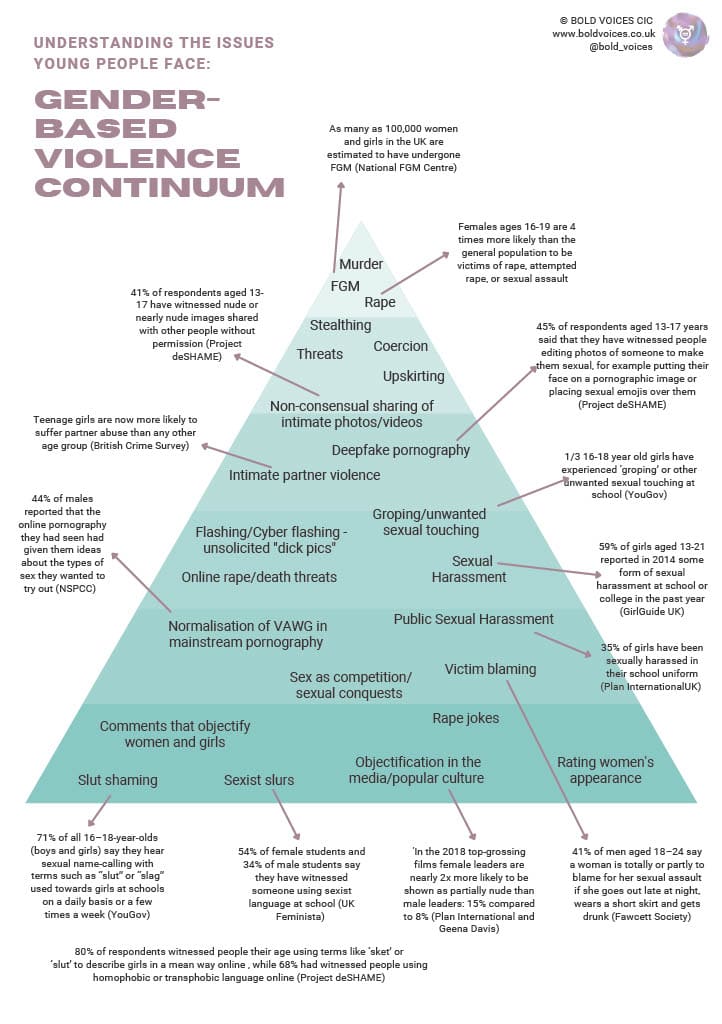Supporting staff and pupils to understand sexism and sexual harassment
Sexism and sexual bullying affect both boys and girls, men and women. Boys may be targets as well as girls, and both sexes may be targets of others who share the same sex. However, sexism and harassment are noted more with females and a third of young females (11-21 years old) have experienced controlling or bullying behaviour from their partners.5
Sexism and sexual bullying may be characterised by name-calling, comments and overt looks about appearance, attractiveness and emerging puberty. It therefore goes beyond normal and acceptable ‘fancying’ to a level that makes an individual feel harassed.
It’s important to be aware of Misogyny, the extreme hatred and contempt for women.
There are lots of suggestions and guidance on what establishments can do to prevent and support children with sexism and sexual harassment. Providing sufficient training to staff so that they can identify signs of sexism and sexual harassment is the first step. Also having this area of education committed into your curriculum will go a long way to prevention and respect.
Keeping children safe in education 2023, outlines a whole establishment approach:
Establishment’s play a crucial role in preventative education. Preventative education is most effective in the context of a whole-establishment approach that prepares children for life in modern Britain and creates a culture of zero tolerance for sexism, misogyny/misandry, and sexual violence/harassment.
The establish must have a clear set of values and standards. These will be underpinned by the establishments behaviour or relational policy and pastoral support system, as well as by a planned programme of evidence-based RSHE delivered in regularly timetabled lessons and reinforced throughout the whole curriculum. Such a programme should be fully inclusive and developed to be age and stage of development appropriate, especially when considering the needs of children with SEND and other vulnerabilities.
This program will tackle, at an age-appropriate stage, issues such as:
- healthy and respectful relationships
- boundaries and consent
- stereotyping, prejudice and equality
- body confidence and self-esteem
- how to recognise an abusive relationship, including coercive and controlling behaviour the concepts of, and laws relating to – sexual consent, sexual exploitation, abuse, grooming, coercion, harassment, rape, domestic abuse, so called ‘honour’-based violence such as forced marriage and Female Genital Mutilation (FGM), and how to access support, and
- what constitutes sexual harassment and sexual violence and why these are always unacceptable.

Source 18
Children with additional needs
Children with Special Educational Needs and Disabilities (SEND) are three times more likely to be abused than their peers.13 Additional barriers can sometimes exist when recognising abuse in SEND children. These can include
- assumptions that indicators of possible abuse such as behaviour, mood and injury relate to the child’s disability without further exploration.
- the potential for children with SEND being disproportionately impacted by behaviours such as bullying and harassment, without outwardly showing any signs
- communication barriers and difficulties overcoming these barriers. Any reports of abuse involving children with SEND will therefore require close liaison with the designated safeguarding lead (or deputy) and the SENCO.
Bullying, prejudice and racism incidents (BPRI) resource 2022